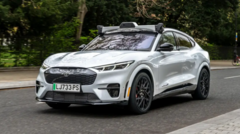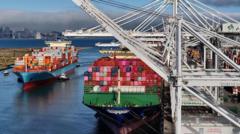The upcoming pilot program, powered by Wayve's technology, signals a cultural shift for transportation in the UK, as new government regulations pave the way for driverless vehicles much earlier than previously projected.
Uber Accelerates Driverless Taxi Trials in the UK

Uber Accelerates Driverless Taxi Trials in the UK
Uber is set to begin trials for autonomous taxis in London as early as next spring, teaming up with AI firm Wayve to navigate regulatory changes.
As Uber prepares for its London trials of driverless taxis, the ride-hailing giant works closely with Wayve, an AI company currently piloting autonomous vehicles with human oversight. Following recent changes to UK regulations, Uber is aiming to roll out this service next spring, despite some uncertainty regarding customer involvement.
The UK government has expedited its regulatory framework for driverless vehicles, initially expected in 2026, and later revised to late 2027. The revised timeline will encourage small commercial services, benefiting the economy and potentially creating thousands of new jobs.
However, labor union representatives warn of potential job losses and the broader social implications of such technology. According to the Department for Transport, the autonomous vehicles industry could generate up to 38,000 jobs and contribute £42 billion to the economy by 2035.
In Austin, Texas, Uber has already launched a robotaxi service, which is proving to be efficient, operating 20 hours a day. Customers can choose robotaxis at no additional cost, while competitors like Tesla aim to introduce similar services soon.
Despite the technological advancements, the safety of fully autonomous vehicles remains under scrutiny. While some studies indicate that robotaxis could lead to fewer accidents than traditional human drivers, there have been several incidents reported, including accidents and operational failures in various locations.
A recent experience in central London revealed Wayve’s autonomous system’s success in navigating complex urban environments without a human driver needing to intervene. The Ford Mach-e vehicle, equipped with advanced sensors and AI technology, responded successfully to multiple hazards, showcasing a cautious and reliable approach to driving.
As the UK prepares for the adoption of driverless vehicles, the landscape of transportation continues to evolve, raising questions about employment, safety, and the future of human-driven rides.
The UK government has expedited its regulatory framework for driverless vehicles, initially expected in 2026, and later revised to late 2027. The revised timeline will encourage small commercial services, benefiting the economy and potentially creating thousands of new jobs.
However, labor union representatives warn of potential job losses and the broader social implications of such technology. According to the Department for Transport, the autonomous vehicles industry could generate up to 38,000 jobs and contribute £42 billion to the economy by 2035.
In Austin, Texas, Uber has already launched a robotaxi service, which is proving to be efficient, operating 20 hours a day. Customers can choose robotaxis at no additional cost, while competitors like Tesla aim to introduce similar services soon.
Despite the technological advancements, the safety of fully autonomous vehicles remains under scrutiny. While some studies indicate that robotaxis could lead to fewer accidents than traditional human drivers, there have been several incidents reported, including accidents and operational failures in various locations.
A recent experience in central London revealed Wayve’s autonomous system’s success in navigating complex urban environments without a human driver needing to intervene. The Ford Mach-e vehicle, equipped with advanced sensors and AI technology, responded successfully to multiple hazards, showcasing a cautious and reliable approach to driving.
As the UK prepares for the adoption of driverless vehicles, the landscape of transportation continues to evolve, raising questions about employment, safety, and the future of human-driven rides.





















